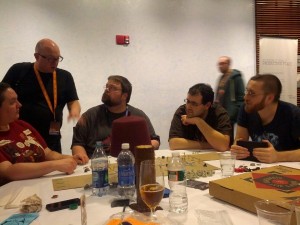
It’s easy to get overwhelmed when you first enter the PAX East show floor. With over 200 exhibitors showing off over 500 products (at a minimum), there’s no way to see it all. In fact, it’s possible to seclude yourself in your own little piece of the Boston Convention and Exhibition Center and not realize that entire other worlds exist within the greater PAX East experience.
The “Three PAX Theory” is the belief that PAX East is actually three different conventions all smashed together. On the north side of the show floor, you have “Triple-A PAX.” That’s where your Nintendos and your Microsofts and your Ubisofts create massive booths, and a game like The Last of Us has a four-hour line. On the south side is “Indie PAX,” which houses the Indie Megabooth and a huge number of small developers who operate booths that are barely big enough for a TV and a few pins. Finally, on the extreme south side of the BCEC is “Tabletop PAX,” where it’s all dice and cards and there’s nary a video game in sight. I wish I had come up with it, but all credit for the “Three PAX Theory” must go to Jake “@jakeninja” Vander Ende.
However, there’s also a fourth side to PAX East that a lot of people don’t see. It takes place in the dark corners of the convention center and in gamer gathering places all across the city after the Expo Hall closes for the night. I like to call this “Shadow PAX.”

Picture Courtesy @perpetualgeek
The first playtest of Kobolds was even visited by a passing Jerry “Tycho” Holkins, who jokingly asked if we pulled the plain cardboard playing surface out of the trash. He then asked us for a quick rundown of the game, and he was fascinated by the explanation of the mechanics behind the game, going back and forth with Anthony about his inspiration. He later apologized for the trash joke and admitted that several similarly early board game projects are currently strewn around Penny Arcade HQ.
Other small developers were making the rounds of this hotel lobby gathering, including Zenas Bellace of QuadraTron Games. He was showing off a four-player Asteroids variant he was working on, as well as his nearly complete twin-stick shooter, Monsters!
A few tables down, Shawn Pierre of OriGamInc had a laptop loaded up with his most recent project, Wiggity Wings, as well as an early prototype of a bubble shooting game known as “Chromality” where two people play on the same controller.
Pierre was enthusiastic about the feedback he received during his impromptu demos, but he’d also love to see a small room set aside for a rotating group of developers to show off their creations away from the show floor: “PAX is all about games, so why not show off more games after the main exhibition ends? I’m sure that a large portion of people attending PAX with normal passes are ones who have a strong desire to be on the production side of games, analog and digital. It would actually be cool if there was an Official ‘Casual’ Exhibition, where hobbyist and aspiring developers were able to show off their games and work. This way, anyone who didn’t get a chance to make it to the Exhibition Hall could still show something off.”
Not content with this “PAX After Dark,” some smaller developers managed to unofficially set up shop on the show floor. One such developer was Thomas Macrina, who took a seat under the escalators and built a “Super Poor Indie Area” to showcase his augmented reality iOS release, Pig Hunt Space. Using his finger as the gun, Macrina hunted virtual pigs in space helmets and chatted with expo goers until an Enforcer evicted him from his spot under the escalators on Sunday.
While Macrina was thrown out of the expo hall, he said the Enforcers couldn’t have been nicer about it: “I’d been demoing my app with signs for about five hours when they approached me. They asked what I was showing off, and only once they confirmed it was a game did they ask me to take my signs down. They said I just couldn’t show it off anywhere in the expo hall, but I was welcome to try anywhere else.”
Macrina also agrees that an official “Super Poor Indie Area” would be a great idea: “A separate area in PAX for indies who don’t want to spend money would be a great idea. Rope off an area next to the bathrooms, or pick out a room, or something. It would take some thinking through, so that it’s fair for the developers who actually shell out cash for real estate, but I think it could be done.” But even with his Enforcer trouble, he declared the experience “worth it.”
The “Shadow PAX” isn’t just for developers, but musicians too. On Friday and Saturday, the PAX 2013 Chiptune Showcase was taking place in the Jamspace, but on Sunday, this unnamed floppy-haired guy (thanks to Eoin Kiely for the video) held his own impromptu concert on the convention center’s skybridge with the assistance of nothing more than two speakers and an old school Game Boy. No one was entirely sure who he was (and I didn’t want to interrupt him), but he was up there for hours.
This is just a small taste of the games and performances that were part of this year’s “Shadow PAX.” Did you play a particularly great game at PAX East that was someone’s personal project? Let us know! Just because PAX East 2013 is over doesn’t mean the “Shadow PAX” has to end.







